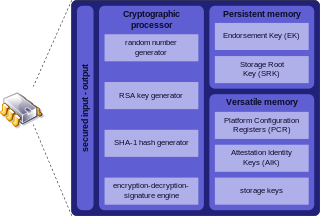
A 19-inch rack is a standardized frame or enclosure for mounting multiple electronic equipment modules. Each module has a front panel that is 19 inches (482.6 mm) wide. The 19 inch dimension includes the edges or "ears" that protrude from each side of the equipment, allowing the module to be fastened to the rack frame with screws. Common uses include computer servers, telecommunications equipment and networking hardware, audiovisual production gear, and scientific equipment.
In telecommunication, the term inside plant has the following meanings:
The Intelligent Network (IN) is the standard network architecture specified in the ITU-T Q.1200 series recommendations. It is intended for fixed as well as mobile telecom networks. It allows operators to differentiate themselves by providing value-added services in addition to the standard telecom services such as PSTN, ISDN on fixed networks, and GSM services on mobile phones or other mobile devices.

In telecommunications, a network interface device is a device that serves as the demarcation point between the carrier's local loop and the customer's premises wiring. Outdoor telephone NIDs also provide the subscriber with access to the station wiring and serve as a convenient test point for verification of loop integrity and of the subscriber's inside wiring.

In telecommunication, the term outside plant has the following meanings:

In fiber-optic communication, a single-mode optical fiber (SMF) is an optical fiber designed to carry only a single mode of light - the transverse mode. Modes are the possible solutions of the Helmholtz equation for waves, which is obtained by combining Maxwell's equations and the boundary conditions. These modes define the way the wave travels through space, i.e. how the wave is distributed in space. Waves can have the same mode but have different frequencies. This is the case in single-mode fibers, where we can have waves with different frequencies, but of the same mode, which means that they are distributed in space in the same way, and that gives us a single ray of light. Although the ray travels parallel to the length of the fiber, it is often called transverse mode since its electromagnetic oscillations occur perpendicular (transverse) to the length of the fiber. The 2009 Nobel Prize in Physics was awarded to Charles K. Kao for his theoretical work on the single-mode optical fiber. The standard G.652 defines the most widely used form of single-mode optical fiber.
A competitive local exchange carrier (CLEC), in the United States and Canada, is a telecommunications provider company competing with other, already established carriers, generally the incumbent local exchange carrier (ILEC).
Transaction Language 1 (TL1) is a widely used management protocol in telecommunications. It is a cross-vendor, cross-technology man-machine language, and is widely used to manage optical (SONET) and broadband access infrastructure in North America. TL1 is used in the input and output messages that pass between Operations Support Systems (OSSs) and Network Elements (NEs). Operations domains such as surveillance, memory administration, and access and testing define and use TL1 messages to accomplish specific functions between the OS and the NE. TL1 is defined in Telcordia Technologies Generic Requirements document GR-831-CORE.

The breakup of the Bell System was mandated on January 8, 1982, by an agreed consent decree providing that AT&T Corporation would, as had been initially proposed by AT&T, relinquish control of the Bell Operating Companies that had provided local telephone service in the United States and Canada up until that point. This effectively took the monopoly that was the Bell System and split it into entirely separate companies that would continue to provide telephone service. AT&T would continue to be a provider of long-distance service, while the now-independent Regional Bell Operating Companies (RBOCs), nicknamed the 'Baby Bells', would provide local service, and would no longer be directly supplied with equipment from AT&T subsidiary Western Electric.

An optical fiber connector terminates the end of an optical fiber, and enables quicker connection and disconnection than splicing. The connectors mechanically couple and align the cores of fibers so light can pass. Better connectors lose very little light due to reflection or misalignment of the fibers. In all, about 100 different types of fiber optic connectors have been introduced to the market.

A raised floor provides an elevated structural floor above a solid substrate to create a hidden void for the passage of mechanical and electrical services. Raised floors are widely used in modern office buildings, and in specialized areas such as command centers, Information technology data centers and computer rooms, where there is a requirement to route mechanical services and cables, wiring, and electrical supply. Such flooring can be installed at varying heights from 2 inches (51 mm) to heights above 4 feet (1.2 m) to suit services that may be accommodated beneath. Additional structural support and lighting are often provided when a floor is raised enough for a person to crawl or even walk beneath.

Trusted Platform Module is an international standard for a secure cryptoprocessor, a dedicated microcontroller designed to secure hardware through integrated cryptographic keys.
Cisco Certifications are the list of the Certifications offered by Cisco Systems. There are four or five levels of certification: Entry (CCENT), Associate (CCNA/CCDA), Professional (CCNP/CCDP), Expert (CCIE/CCDE) and recently Architect, as well as nine different paths for the specific technical field; Routing & Switching, Design, Industrial Network, Network Security, Service Provider, Service Provider Operations, Storage Networking, Voice, Datacenter and Wireless.
There are also a number of the specialist technician, sales, Business, data center certifications, CCAI certified instructor.
A rugged, or ruggedizedcomputer is a computer specifically designed to operate reliably in harsh usage environments and conditions, such as strong vibrations, extreme temperatures and wet or dusty conditions. They are designed from inception for the type of rough use typified by these conditions, not just in the external housing but in the internal components and cooling arrangements as well.
Telecom Valley was an area located in Sonoma County, California specifically the Redwood Business Park of Petaluma, California.

Telecommunications Engineering is an engineering discipline centered on electrical and computer engineering which seeks to support and enhance telecommunication systems. The work ranges from basic circuit design to strategic mass developments. A telecommunication engineer is responsible for designing and overseeing the installation of telecommunications equipment and facilities, such as complex electronic switching systems, and other plain old telephone service facilities, optical fiber cabling, IP networks, and microwave transmission systems. Telecommunications engineering also overlaps with broadcast engineering.

The Bell System was the system of companies, led by the Bell Telephone Company and later by AT&T, that dominated the telephone services industry in North America for 100 years from its creation in 1877 until its antitrust breakup in the early 1980s. The system of companies was often colloquially called Ma Bell, as it held a vertical monopoly over telecommunication products and services in most areas of the United States and Canada. At the time of the breakup of the Bell System in the early 1980s, it had assets of $150 billion and employed over one million people.

An ESD simulator, also known as an ESD gun, is a handheld unit used to test the immunity of devices to electrostatic discharge (ESD). These simulators are used in special electromagnetic compatibility (EMC) laboratories. ESD pulses are fast, high-voltage pulses created when two objects with different electrical charges come into close proximity or contact. Recreating them in a test environment helps to verify that the device under test is immune to static electricity discharges.

The Cisco Certified Internetwork Expert, or CCIE, is a technical certification offered by Cisco Systems. The Cisco Certified Internetwork Expert (CCIE) and Cisco Certified Design Expert (CCDE) certifications were established to assist the industry in distinguishing the top echelon of internetworking experts worldwide and to assess expert-level infrastructure network design skills worldwide. These certifications are generally accepted worldwide as the most prestigious networking certifications in the industry. The CCIE and CCDE community has established a reputation of leading the networking industry in deep technical networking knowledge and are deployed into the most technically challenging network assignments. The expert-level certification program continually updates and revises its testing tools and methodologies to ensure and maintain program quality, relevance and value. Through a rigorous written exam and a performance-based lab exam, these expert-level certification programs set the standard for internetworking expertise.
LTE in unlicensed spectrum is a proposed extension of the Long-Term Evolution (LTE) wireless standard intended to allow cellular network operators to offload some of their data traffic by accessing the unlicensed 5 GHz frequency band. LTE-Unlicensed is a proposal, originally developed by Qualcomm, for the use of the 4G LTE radio communications technology in unlicensed spectrum, such as the 5 GHz band used by 802.11a and 802.11ac compliant Wi-Fi equipment. It would serve as an alternative to carrier-owned Wi-Fi hotspots. Currently, there are a number of variants of LTE operation in the unlicensed band, namely LTE-U, License Assisted Access (LAA), and MulteFire.











